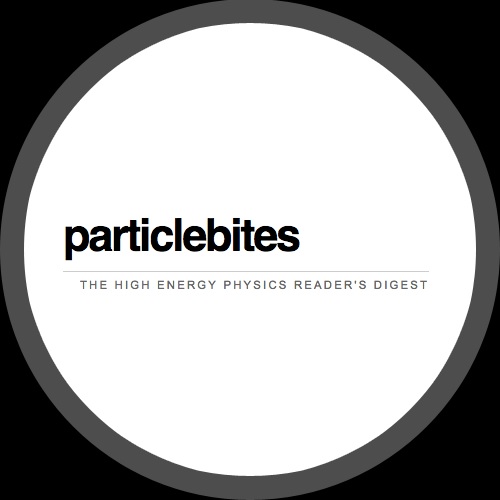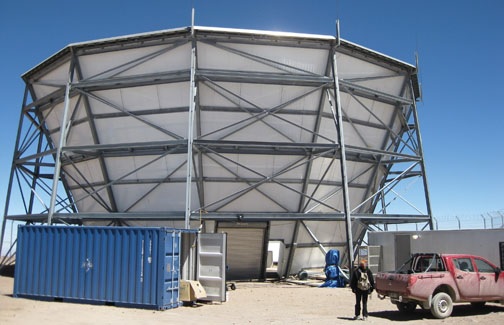August 17, 2016 [Just brought to social media by astrobites.]
Eve Vavagiakis
Article: Detection of the pairwise kinematic Sunyaev-Zel’dovich effect with BOSS DR11 and the Atacama Cosmology Telescope
Authors: F. De Bernardis, S. Aiola, E. M. Vavagiakis, M. D. Niemack, N. Battaglia, and the ACT Collaboration
Reference: arXiv:1607.02139
Editor’s note: this post is written by one of the students involved in the published result.
Like X-rays shining through your body can inform you about your health, the cosmic microwave background (CMB) shining through galaxy clusters can tell us about the universe we live in.
When light from the CMB is distorted by the high energy electrons present in galaxy clusters, it’s called the Sunyaev-Zel’dovich effect. A new 4.1σ measurement of the kinematic Sunyaev-Zel’dovich (kSZ) signal has been made from the most recent Atacama Cosmology Telescope (ACT) cosmic microwave background (CMB) maps and galaxy data from the Baryon Oscillation Spectroscopic Survey (BOSS).
With steps forward like this one, the kinematic Sunyaev-Zel’dovich signal could become a probe of cosmology, astrophysics and particle physics alike.
The Kinematic Sunyaev-Zel’dovich Effect
It rolls right off the tongue, but what exactly is the kinematic Sunyaev-Zel’dovich signal? Galaxy clusters distort the cosmic microwave background before it reaches Earth, so we can learn about these clusters by looking at these CMB distortions. In our X-ray metaphor, the map of the CMB is the image of the X-ray of your arm, and the galaxy clusters are the bones. Galaxy clusters are the largest gravitationally bound structures we can observe, so they serve as important tools to learn more about our universe. In its essence, the Sunyaev-Zel’dovich effect is inverse-Compton scattering of cosmic microwave background photons off of the gas in these galaxy clusters, whereby the photons gain a “kick” in energy by interacting with the high energy electrons present in the clusters.
The Sunyaev-Zel’dovich effect can be divided up into two categories: thermal and kinematic. The thermal Sunyaev-Zel’dovich (tSZ) effect is the spectral distortion of the cosmic microwave background in a characteristic manner due to the photons gaining, on average, energy from the hot (~107 – 108 K) gas of the galaxy clusters. The kinematic (or kinetic) Sunyaev-Zel’dovich (kSZ) effect is a second-order effect—about a factor of 10 smaller than the tSZ effect—that is caused by the motion of galaxy clusters with respect to the cosmic microwave background rest frame. If the CMB photons pass through galaxy clusters that are moving, they are Doppler shifted due to the cluster’s peculiar velocity (the velocity that cannot be explained by Hubble’s law, which states that objects recede from us at a speed proportional to their distance). The kinematic Sunyaev-Zel’dovich effect is the only known way to directly measure the peculiar velocities of objects at cosmological distances, and is thus a valuable source of information for cosmology. It allows us to probe megaparsec and gigaparsec scales – that’s around 30,000 times the diameter of the Milky Way!

A schematic of the Sunyaev-Zel’dovich effect resulting in higher energy (or blue shifted) photons of the cosmic microwave background (CMB) when viewed through the hot gas present in galaxy clusters. Source: UChicago Astronomy.
Measuring the kSZ Effect
To make the measurement of the kinematic Sunyaev-Zel’dovich signal, the Atacama Cosmology Telescope (ACT) collaboration used a combination of cosmic microwave background maps from two years of observations by ACT. The CMB map used for the analysis overlapped with ~68000 galaxy sources from the Large Scale Structure (LSS) DR11 catalog of the Baryon Oscillation Spectroscopic Survey (BOSS). The catalog lists the coordinate positions of galaxies along with some of their properties. The most luminous of these galaxies were assumed to be located at the centers of galaxy clusters, so temperature signals from the CMB map were taken at the coordinates of these galaxy sources in order to extract the Sunyaev-Zel’dovich signal.
While the smallness of the kSZ signal with respect to the tSZ signal and the noise level in current CMB maps poses an analysis challenge, there exist several approaches to extracting the kSZ signal. To make their measurement, the ACT collaboration employed a pairwise statistic. “Pairwise” refers to the momentum between pairs of galaxy clusters, and “statistic” indicates that a large sample is used to rule out the influence of unwanted effects.
Here’s the approach: nearby galaxy clusters move towards each other on average, due to gravity. We can’t easily measure the three-dimensional momentum of clusters, but the average pairwise momentum can be estimated by using the line of sight component of the momentum, along with other information such as redshift and angular separations between clusters. The line of sight momentum is directly proportional to the measured kSZ signal: the microwave temperature fluctuation which is measured from the CMB map. We want to know if we’re measuring the kSZ signal when we look in the direction of galaxy clusters in the CMB map. Using the observed CMB temperature to find the line of sight momenta of galaxy clusters, we can estimate the mean pairwise momentum as a function of cluster separation distance, and check to see if we find that nearby galaxies are indeed falling towards each other. If so, we know that we’re observing the kSZ effect in action in the CMB map.
For the measurement quoted in their paper, the ACT collaboration finds the average pairwise momentum as a function of galaxy cluster separation, and explores a variety of error determinations and sources of systematic error. The most conservative errors based on simulations give signal-to-noise estimates that vary between 3.6 and 4.1.

The mean pairwise momentum estimator and best fit model for a selection of 20000 objects from the DR11 Large Scale Structure catalog, plotted as a function of comoving separation. The dashed line is the linear model, and the solid line is the model prediction including nonlinear redshift space corrections. The best fit provides a 4.1σ evidence of the kSZ signal in the ACTPol-ACT CMB map. Source: arXiv:1607.02139.
The ACT and BOSS results are an improvement on the 2012 ACT detection, and are comparable with results from the South Pole Telescope (SPT) collaboration that use galaxies from the Dark Energy Survey. The ACT and BOSS measurement represents a step forward towards improved extraction of kSZ signals from CMB maps. Future surveys such as Advanced ACTPol, SPT-3G, the Simons Observatory, and next-generation CMB experiments will be able to apply the methods discussed here to improved CMB maps in order to achieve strong detections of the kSZ effect. With new data that will enable better measurements of galaxy cluster peculiar velocities, the pairwise kSZ signal will become a powerful probe of our universe in the years to come.
Implications and Future Experiments
One interesting consequence for particle physics will be more stringent constraints on the sum of the neutrino masses from the pairwise kinematic Sunyaev-Zel’dovich effect. Upper bounds on the neutrino mass sum from cosmological measurements of large scale structure and the CMB have the potential to determine the neutrino mass hierarchy, one of the next major unknowns of the Standard Model to be resolved, if the mass hierarchy is indeed a “normal hierarchy” with ν3 being the heaviest mass state. If the upper bound of the neutrino mass sum is measured to be less than 0.1 eV, the inverted hierarchy scenario would be ruled out, due to there being a lower limit on the mass sum of ~0.095 eV for an inverted hierarchy and ~0.056 eV for a normal hierarchy.
Forecasts for kSZ measurements in combination with input from Planck predict possible constraints on the neutrino mass sum with a precision of 0.29 eV, 0.22 eV and 0.096 eV for Stage II (ACTPol + BOSS), Stage III (Advanced ACTPol + BOSS) and Stage IV (next generation CMB experiment + DESI) surveys respectively, with the possibility of much improved constraints with optimal conditions. As cosmic microwave background maps are improved and Sunyaev-Zel’dovich analysis methods are developed, we have a lot to look forward to.
See the full article here .
Please help promote STEM in your local schools.
What is ParticleBites?
ParticleBites is an online particle physics journal club written by graduate students and postdocs. Each post presents an interesting paper in a brief format that is accessible to undergraduate students in the physical sciences who are interested in active research.
The papers are accessible on the arXiv preprint server. Most of our posts are based on papers from hep-ph (high energy phenomenology) and hep-ex (high energy experiment).
Why read ParticleBites?
Reading a technical paper from an unfamiliar subfield is intimidating. It may not be obvious how the techniques used by the researchers really work or what role the new research plays in answering the bigger questions motivating that field, not to mention the obscure jargon! For most people, it takes years for scientific papers to become meaningful.
Our goal is to solve this problem, one paper at a time. With each brief ParticleBite, you should not only learn about one interesting piece of current work, but also get a peek at the broader picture of research in particle physics.
Who writes ParticleBites?
ParticleBites is written and edited by graduate students and postdocs working in high energy physics. Feel free to contact us if you’re interested in applying to write for ParticleBites.
ParticleBites was founded in 2013 by Flip Tanedo following the Communicating Science (ComSciCon) 2013 workshop.

Flip Tanedo UCI Chancellor’s ADVANCE postdoctoral scholar in theoretical physics. As of July 2016, I will be an assistant professor of physics at the University of California, Riverside
It is now organized and directed by Flip and Julia Gonski, with ongoing guidance from Nathan Sanders.


